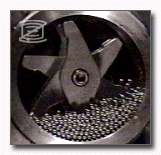|
 In principle it is desired for a high potential ball mill that as In principle it is desired for a high potential ball mill that as
possible high deformation energy per volume grinding media is transferred.
Due to these considerations it follows that the most efficient system
consists of small and highly accelerated balls which reaches a high kinetic
energy despite its small sizes.
On this principle the Zoz-design of a High-Kinetic-Rotary-Ball-Mill is based,
the Simoloyer®.
The horizontal arrangement of the grinding unit eliminates during processing
the influence of gravity on grinding media and powder material. So “death
zones” inside the vessel are avoided and a homogenous distribution of balls
and powder res. the collision process is reached.
The homogenous distribution avoids a irregular processing behaviour and
guarantees a small size distribution of mill feed.
The advancement of conventional drum mill is the stationary arrangement of
the vessel (drum) and the transfer of energy by a rotor (not gravity).
As grinding media, a huge amount of single balls, very often standard steel
(100Cr6) with a diameter of 5mm is used. Other materials are available as
well.
The rotor, made by rotor-shaft and –arms, accelerates the grinding media to
high velocity. The parameter of the maximum relative velocity speed of the
balls is given by the diameter of the rotor and its rotational speed.
For calculation a constant maximum relative velocity speed of the balls in
different sizes of grinding units this simple physical correlation explains
that the rotary speed has to be reduced with increasing diameter of the
rotor. This is a main advantage in up-scaling calculations. Furthermore a
compact design is possible in comparison to drum-mills.

Another influencing variable of the finally important (average) velocity of
the balls is the filling ratio of vessel; a increasing amount of grinding
media leads to a mutual deceleration. A recommendation, determined in pilot
tests, is a filling ratio of <40% (volume of vessel). Despite the small mass
a high velocity and finally a high kinetic of a single ball is reached.
In opposite to the conventional drum-mills the principle is based on a
high amount of collision, not only shear and friction. A higher filling
ratio would reduce the free flight path of the balls which again would lead
to an increase of shear and friction again.
-
Due to the large amount of single balls with a small diameter a huge
amount of punctual contact zones are available which results in high
deformation pressures.
-
The inserted milling-work is increased due to the realisable high kinetic
velocity.
-
A reduction in size is not prospective because the accelerated component
pars are small and low in inertia in comparison to conventional drum-mills.
-
Due to the
horizontal arrangement a homogenous particle size reduction is provided.
|